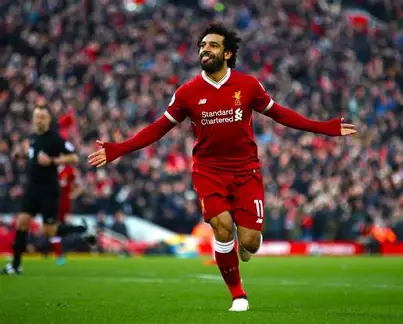
While in Rome, Liverpool striker Mohamed Salah read about Olympic gold-medal-winning swimmer Michael Phelps using meditation and visualisation to improve his performances. From then on, Salah started incorporating such training techniques into his daily routine, spending a few minutes after waking each morning closing his eyes and imagining himself in different scoring positions.
The Egyptian danger man would combine this with researching goalkeepers he was coming up against in games.
“His robustness is one of the factors behind him consistently producing the form he has,” says Dr James Malone, a sports scientist who has worked in the Premier League, including at Liverpool between 2010 and 2013.
While he does point to Salah’s low centre of gravity, “well-conditioned” physique and recovery work as being part of that robustness, Malone also says it can be attributed to the way he plays. “He’s very selective with his movement,” he adds. “It’s similar to Cristiano Ronaldo and Lionel Messi; they do run and they are intense when they run but they’re very selective when they engage with certain actions.
“For example, you won’t see Salah running around putting in sliding tackles. He’ll typically jump out of the way of things. In that way, he protects himself in games and then when the ball comes and he engages in the attack, he comes alive and starts to do his high-intensity movement.”
Salah told L’Equipe about how he will “analyse (an opponent’s) posture to anticipate their intervention”, with his speed and mobility work giving him a head start.
But while that approach has long been part of Salah’s game, the 2024-25 campaign saw a shift in the way he has been deployed. He is making fewer off-ball runs than ever, using the seven seasons of available data from SkillCorner.
Not only is he making fewer runs, but he is also accelerating less. His high-intensity accelerations (runs exceeding 3m/s²) have dropped from 10.97 per game in 2023-24 to 8.95 last season. Yet this is not representative of a sudden physical decline, but rather a tactical realignment from the new manager. They have certainly not affected his productivity.
Rather than diminishing his impact, these changes have made him even more effective. He is choosing his moments more selectively, and his runs are leading to more shots and goals than ever before. Salah generated almost 2.5 shots per game from his off-ball movement last season, the highest in the data available since 2018-19, despite moving less frequently.
The other notable change in Salah’s movement last season was where his off-ball runs began. Under Slot, Salah’s running patterns mimicked more traditional wing-play patterns, in contrast to the advanced inside-forward role he occupied in Klopp’s system.
With this shift, Salah is now starting his runs from deeper positions. His share of runs starting in advanced areas has declined significantly, dropping from 56 per cent in 2019-20 to 44 per cent last season.
By shifting his starting position, Salah is operating with more space in front of him, giving him a clearer runway to build speed before engaging defenders.
From 2018-19 onwards, Salah has started his runs progressively further from the nearest defender, a trend that could be as much about defensive adaptations as it is about his own movement.
Opposition defenders may now be wary of pressing too tightly, instead allowing themselves more time to react to his devastating bursts forward. Whether a deliberate strategy from Liverpool or a reactionary measure from opponents, the increased distance between Salah and his marker gives him more time to accelerate into space.
This extra space has preserved his effectiveness and allowed him to reach even greater speeds. His peak sprint velocity last season of 31.1 km/h is his highest on record, showing that while his frequency of high-intensity accelerations has declined, his ability to hit top-end remains undiminished.
Nutrition is another cornerstone, and one that Salah places so much importance on that he has been known to pay close attention to how his team-mates are eating, too.
In pre-season before the 2021-22 season, he spotted Liverpool youngster Harvey Elliott with two pieces of white bread on his plate and advised him to halve his intake. “My breakfast is mainly bread with beans or avocado,” Elliott told The Times in 2022. “Now I have changed it to brown bread, which is a lot healthier.”
In a light-hearted interview with Men in Blazers last year, Salah was asked by the host how he might get his kind of abdominal muscles. “You need to cut bread, or at least have gluten-free bread,” Salah replied. “Less dairy, don’t eat cheese that much and stay in the green stuff… and cut out the sugar, as well.”
Salah has listed broccoli, sweet potatoes, fish, chicken and salad as his favoured foods, and sushi when he eats out. He allows himself pizza once a month, loves burgers but hardly ever eats them and allows himself a koshari (a dish made with pasta, rice, lentils, chickpeas and spices) whenever he returns to Egypt.
Alcohol never comes into the equation as Salah, a practising Muslim, is teetotal – something Jurgen Klopp once hailed as part of the reason he and then-team-mate Sadio Mane could recover so swiftly from playing seven matches in the 2022 AFCON.
Dr Rob Naughton, a performance nutritionist who has worked with clubs and privately with international players on behalf of Intra Performance Group, explains that carbohydrates are the key fuel for footballers but that it’s important that intake is periodised. “They’ll have low training days where carbohydrate demands are low but then when you’re building up for a game, you need to bring it up,” he says. “That’s a way of helping players to maintain an optimal body composition while also ensuring they are fuelling their match demands.”
Salah might choose alternative sources of carbohydrates to bread but Naughton says that it’s important that each player finds what works best for them.
“One of the clubs I work with provides gluten-free pasta. When eating larger amounts of wheat-based pasta (as they might the day before a game), some players will bloat a bit and we’ve found that we get this symptom less frequently when choosing a gluten-free option.”
Salah’s performances last season were an accumulation of many factors, both on and off the pitch. The thread that connects them all is his willingness and desire to do everything he can to perform at his best, no matter what his age.
“Whether it’s breathwork, visualisation, meditation, pilates, yoga, core training, to do that stuff every day, day in, day out, requires an enormous amount of discipline, effort and consistency,” says Rosenblatt. “And that’s not even talking about the football, too!”
But can Salah really keep improving as he hits his mid-thirties? Rosenblatt describes working with a player who has recently hit a personal best in their peak speed at the age of 33, and says it isn’t all that unusual.
“I’ve worked with other athletes who are peaking in their power and explosive outputs at later stages of their careers – it’s simply because they’ve invested effort and energy into it,” he says. “It’s the willingness to do everything around football and deliver consistently that is really critical, and impressive.
“Even with a significant injury history, if a player has the mind-set that they’re going to do more than just extend their career, you could have someone who’s going to keep getting better physically, has a ton of experience and knows how to play the game. That’s a very dangerous player — and that’s what you’re seeing with Salah.”
- A Tell Media / Adapted from The Athletic







